
![]()

|
|
|
|
|
|
Britain and Scotland
Page 4
|
|
|
|
|
|||||||||||||
|
Plaid Badge of the Highland Light Infantry (Item BRITSCOT 4-1) |
|||||||||||||
| DESCRIPTION: This great plaid badge of the HLI dates about from early times according to the battle honors that go all around the edges such as Waterloo, Egypt, Pyrenees, Alma, Indostan, Vittoria, Peninsula. There are 30 battle honors running around it, but none seem as late as WWI. So it could well be assumed that this brooch could be much earlier. It’s constructed with a three-piece method with the badge being the last applied section. We’ll not go into the history of this elite Scottish regiment since so much can be found on the net. They are the most-celebrated regiment of foot in the British army. We will say that the name Highland Light Infantry evolved after it was adopted by the 71st Highlanders in 1809 as the first clan regiment at the outbreak of the American War of Independence. Later, in 1881, the 71st and 74th regiments of foot were redesignated as the 1st and 2nd Battalions, respectively, of the Highland Light Infantry. Do see our dress dirk of the 74th Highland Regiment at Item BRITSCOT 2-10. The brooch is massive measuring 4 inches in diameter. It’s heavy and probably silver-plated bronze. It has what looks like handmade nut fasteners that secure the front plate to the back plate. A strong pin is attached for fastening the brooch to the usually quite thick plaid of the uniform. All in all this is a very beautiful piece of Highland Scottish military gear. It’s probably quite rare, but certainly important to the glory that is and was Scotland the brave!
PRICE: $580.00; very reasonable |
|
|||
|
RAF Chaplain’s Wings (Item BRITSCOT 4-2) |
|||
| DESCRIPTION: This is a rare piece as RAF insignia go. It is a special wing for chaplains of the service. Possibly, the parson who wore this might have been one of those men of God who blessed the bomber crews who set out on the 13th & 14th of 1945 to bomb the nonmilitary or industrial city of Dresden. This terror bombing was ordered by Churchill and carried out by “bomber” Arthur Harris. The city was called the Florence on the Elbe and was one of the greatest cultural landmarks in the worlds. The victorious allies destroyed 80 percent of the city with the dead counted at various figures up to 135,000. There were so many refugees in the city that the real figure will almost certainly never be known. Why? The most plausible theory is the murderous terror raids were carried out to demonstrate to the Russians and Stalin the awesome power of the allies and to act as a warning to them not to stray from the agreements that the had made at the war conferences. An internal RAF memo spreads some light on the reason for the bombing. Go to the bombing of Dresden on the history learning site on Google to see this RAF memo. So, dear reader, the RAF actually had a chaplain corps and no doubt the pious reverends did in fact bless those bombs, bombers, and crew who set out on this famed, infamous mission. But prayers for the success of the raids certainly were not welcomed by the God that I know. There is, however, another entity (a deity) who no doubt appreciated it and has bomber Arthur Harris as his permanent guest down there.
PRICE: $125.00; money not well spent |
|
|
||||||||||||
|
Pilot Helmet and Goggles (Item BRITSCOT 4-4) |
||||||||||||
| DESCRIPTION: We are not sure of the period of this set; it might be WWII. It is in great condition and perfect for playing “Snoopy and the Red Baron”. Wish we knew more but that is it unfortunately. We do know it is well made and genuine military.
PRICE: $185 the set. |
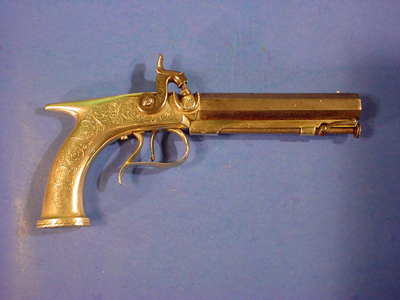 |
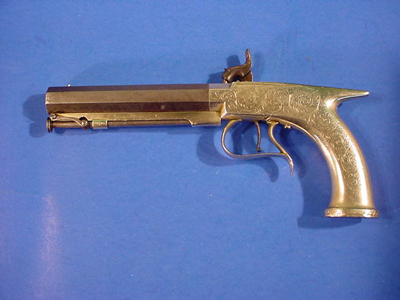 |
Scottish Percussion Pistol with All Steel Frame (Item BRITSCOT 4-5) |
||||
DESCRIPTION: This is a quite unusual Scottish steel pistol by the famous firm of John Dixon and Son of Edinburgh. Dixon guns are some of the most sought after rifles and pistols today. Dixon was an inventive maker producing many variations on a theme. This pistol is only typically Scottish in that it has the all steel frame and the octagon Barrel. We believe it was a holster pistol made most likely for Scottish Police Constables or detectives. Unlike most Scottish pistols of the 17th and 18th centuries this weapon does not have the long belt hook that is usually found on fine Scottish pistols -- flintlock or percussion.
It is generally smaller as well measuring about 9 inches from the end of the barrel to the back of the grip. It is nicely engraved with a floral pattern over the lock sides, hammer, butt, and trigger guard. The top of the barrel has the name John Dixon and Son Edinburgh. This prestigious firm was located in Princess Street, Edinburgh, Scotland and they turned out fine firearms from 1894 to 1929.
The way this pistol fits into the hand is just different and great. It rather “cuddles” the hand and the fingers. Straddle the trigger guard. The ram-rod is quite innovative in that it pulls forward and stays literally attached to the gun with a hinge that is placed underneath the barrel. So here is a typical but non-typical Scottish pistol by one of the best known of the Scots arms maker. Extremely rare but priced very reasonably. |
||||
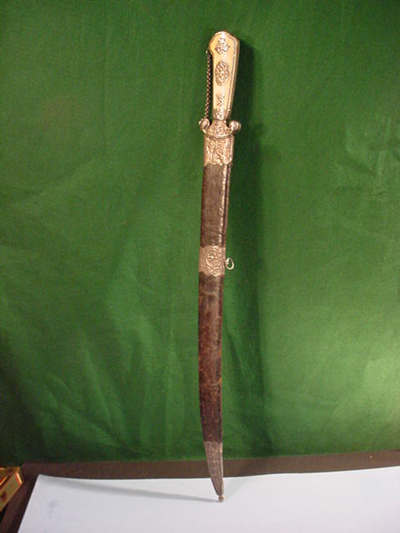 |
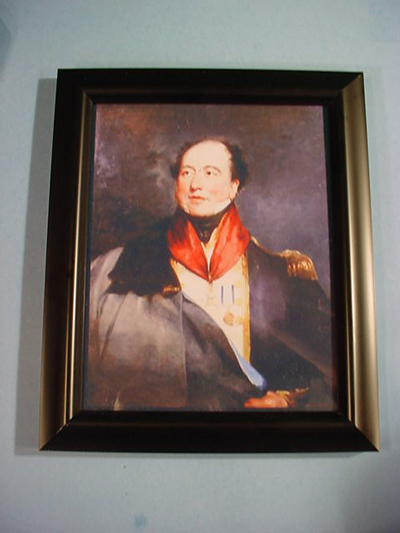 Captain Cole, Royal Navy |
A Beautiful French Hunting Cutlass Captured in Battle |
||||
DESCRIPTION: This is a wonderful museum piece (personified!). It is a French hunting sword that is bone and silver mounted, possibly dating back to the 17th century but could be as late as 1750. This weapon was captured by Captain Sir Christopher Cole of the British Royal Navy. Captain Cole was the skipper of the famed HMS Caroline and the Rippon, a 36 gun frigate in service against the French and earlier against the Dutch. The internet is replete with the adventures of Captain Sir Christopher Cole so we will not explore his illustrious career here at this time. He served as a Member of Parliament after his life of high adventures on the sea had ended. He had also served in the rank of Colonel in the Royal Marines. He was invested as a Knight Commander (Order of the Bath) (KCB) in 1814. The sword or hunting weapon that we offer was captured from a French Captain during Captain Cole's many daring sea engagements. The style of hunting sword is longer than the usual and quite fancy indeed. Why would a French Captain be armed with a hunting sword instead of a naval sword? This is a speculative question but it can be supposed that it was a family heirloom and probably from a family of aristocracy as this weapon was obviously made by a swordsmith of the ‘master craft.’ The beauty of it is obvious. And please pay attention to the standing Turk on the blade that is commenserate with the memory of Prince Eugene of Savoy who defeated the Turks at the Battle of Vienna. Prince Eugene was born in Paris and was a hereditary Prince of the Royal House of Savoy. The French had a love/hate relationship with the Turks and Muslims, using them as allies from time to time but also fighting them in other eras. But many of the weapons of Austrians, Hungarians and the French often depict a fierce Turk in the blades of especially these styles of hunting weapons. The shape and style of the sword is very Islamic looking and this was favored by the French noble classes. We earnestly believe the French Captain who surrendered to Captain Cole was of French gentry at least, and Capt Cole treasured the sword enough that he had his name and R.N. (Royal Navy) engraved under the cross guard. (Shown in our pictures). We also believe this to be more than likely a mid-17th century sword (maybe 1650 or so.) It is of sword length -- 31" long in its scabbard. The beautiful silver decorative plaques that lie upon the gorgeous bone grips stand out boldly. The silver fittings on the scabbard are at some places repaired with silver overlay -- the scars of battle? Probably! The blade is about 21 ½" long and except for some old antiqued rust spots, it is quite excellent for its age and past usage. It would be rated as (museum grade excellent) and for a weapon of this age to have its leather and wood scabbard still there and fine is the incredible bone grip, but it has the minute age cracks to be expected on a weapon as old as this one. Back to the blade... it has about 8 engraved pictographs including the Turk. Some of the engraved parts at the base of the blade where it meets the cross guard are quite worn indicating that it was drawn often and used possibly through the many years. This was not the weapon of any peasant or even a lower class noble; it was surely the property of a highly placed Royal personage or at least fabulously wealthy landed gentry. It’s a superlative weapon worthy of display in the finest museum or very advanced collection. We have handled many fine pieces at Germania but this one is worthy of bragging about. A sword of elegant beauty but also it has the distinction of having belonged to a French officer and an illustrious British sea-going Knight of the Bath and M.P. Fantastic! PRICE: SOLD |
||||
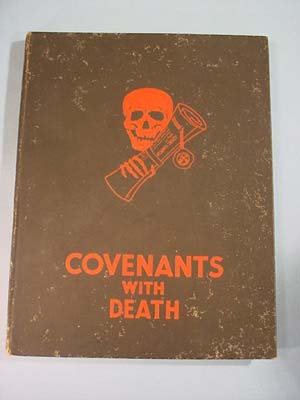 |
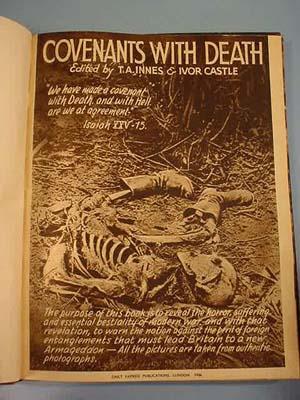 |
“Covenants with Death” Edited by T.A. Innes & Ivor Castle |
DESCRIPTION: This book was published by the Daily Express Publication’s in London in 1934. It was a sensible compelling pictorial book that warns the public about entering another war (WW II). The first words in it are: “We have made a covenant with death, and with Hell are we in agreement. Isaiah XXV-15." The editors go on to say, “The purpose of this book is to reveal the horror, suffering and essential bestiality of modern war and with that revelation, to warn the nation against the peril of foreign entanglements that must lead Britain to a new Armageddon – all the pictures are taken from authentic photos.” The book contains hundreds of pictures of war and mayhem. Suffering of civilians, murderous battles and innocent victims the deaths in horrible circumstance of the young soldiers on all sides. Pictures galore of dead men strewn all over the so-called Fields of Glory, front line execution, torture inflicted in the most heinous manner. Destruction rampant against sacred places, over the top of the trenches to certain death, the terrible gas warfare and all for what? The book measures 9" x 11" and is in good shape except for some minor mildew on the cover; now no longer harmful. It is a nightmare book and I wish it could be required reading in every school classroom in the Western world. War is Hell. And fratricidal war is “hell personified”! We at Germania International, LLC deal in military relics and the trappings of war, but I assure you we hate war and wish that there would never be another one. To the swine that promote war for their own greedy ends and political agenda, war is just another form of politics. For the young soldier in the field it is the "Dance with Death." Why not let the kings, presidents, congresses and senators go out there and duke it out with bowie knives! Look at these pictures and repeat after me “No more brother wars.” PRICE: SOLD Very, very, rare and prodigiously important. |
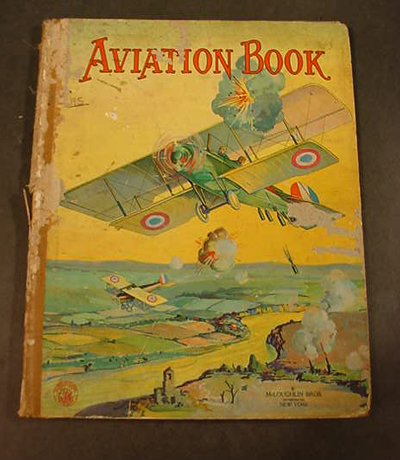 |
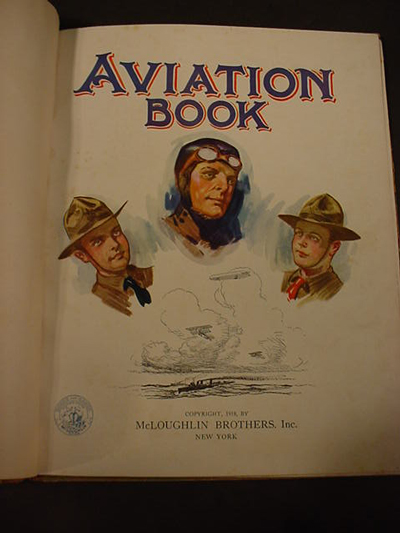 |
Book: The Aviation Book (Item WWI 11-10 & BRITSCOT 4-8) |
||
DESCRIPTION: This is a children's book published in 1918. It is a colorful book and in large format, measuring 10" x 13" in size. The binding edge is rather distressed and obviously used considerably by the Boy Scouts that it was intended for. The pages and pictures are in very good shape. I would have to say it is quite rare, although typical of the primers of those turbulent times when white, Christian brothers fought and killed each other for no good reason. PRICE: $265.00 Rare! |
||
|
| Set of Toy Soldiers by Elastolin (Item BRITSCOT 4-9) |
DESCRIPTION: This is a set of 17 figures representing the Coldstream Guards with band figures marching. Elastolin was a company making composition figures made of sawdust, casein glue and clay then hand painted at the factory. The technique was developed by the brothers Otto and Max Hausser in 1912. This set harkens back to the earliest toy soldiers made by the Haussers’. It is comprised of a officer mounted on a horse leading the group, five bandsmen who immediately follow, a flag bearer with British flag and to each side of him are an officer with drawn sword and a guardsman with rifle. Drawing up behind them are soldiers who march along. All the figures are in good shape except some original paint has worn off in the 99 years or so since they probably were made. The only figure in need of a better repair job is the band leader who got mad at a recruit perhaps and ‘lost his head.’ The head however is there, but someone did a sloppy glue job (an easy repair for you). The marching figures are 4 ¼ inches high including the base. The bases are marked Elastolin, but also you can see numbers and letters on the bases that have been painted there. The reason for this is as follows: there are 3 planchets representing the parade ground included with this group. This was a very clever display fixture. When inserting the figures into their proper positions there are form fitting holes all numbered and lettered for acceptance of each piece. This makes for easy group assemblage as each number and letter matches the information on the bottom of each figure. This was brilliant thinking as the pieces when inserted are firmly in place and very stable while in this display (“Ingenious”), but the parade ground was probably not made by Elastolin. We would think this wonderful early 20th century toy soldier set would be quite rare and certainly highly desirable to the toy collector. German toys like this are the best! They are not as refined in feature and form like the new plastic ones from China but the modern ones just don’t have the charm and meaning as the antiques do. PRICE: $2,500.00 the set; Very special sale - - Reduced to $1,200.00 |
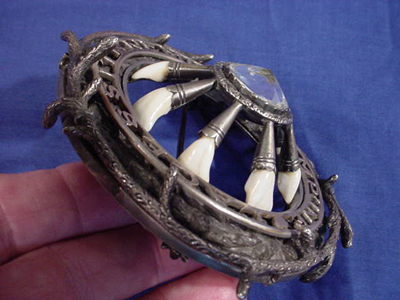 |
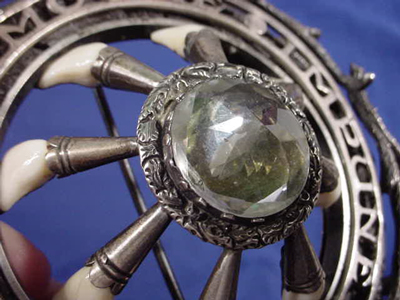 |
Magnificent Scottish Brooch (Item BRITSCOT 4-10; SCOTWEAPON 1-16) |
DESCRIPTION: This is without a doubt one of the greatest Scottish relics we have ever found. It is a large silver plaid brooch with beauty that stokes the imagination and invokes historical curiosity. It was found in Scotland and it certainly seems to be custom made for a royal personage or an important individual. The brooch was purchased from a Scottish farmer who came to an antique show that we attended in London. He wished to remain anonymous. The brooch was handmade obviously by a very talented jeweler...it is unsigned unfortunately. In its very center is a perfect precious stone, probably white amethyst (Cairngorm). Emitting from this are silver cones that hold 8 genuine elk's teeth while around this is a metal circle fashioned in silver with the Latin motto Nemo Me Impune Lacessit! Translated “No One Attacks Me with Impunity.” This is the motto of the Order of the Scottish Thistle and of three regiments of the British Army. This silver circular devise is laid over a setting of wood on which Scottish thistles are carved and all around the edges are tree branches fashioned in silver. NOW there is a distinct possibility that this was a gift to John Brown. And that was what we were told. At the time of the purchase, Brown was a Scottish personal servant and favorite of Britain’s Queen Victoria. For many years he was appreciated by many including the Queen for his competence and companionship and highly resented by others for his influence and informal manner. The exact nature of his relationship with the Queen was the subject of great speculation by contemporaries and continues to be controversial even today. After Prince Albert died in 1861, Brown became Victoria’s personal servant. She was so grateful for his service and his manner toward her, which was much less formal than that of her other servants, Brown was tough and extremely protective of her majesty and due to that fact she awarded him many medals and other wonderful gifts and she had portraits made of him. So, it is a distinct possibility that this indeed was one of the precious gifts that John Brown received from the gracious Queen. This is a very large and heavy brooch measuring about 4 inches in diameter and quite heavy, only a man of large stature like “Wee Jon” would wear. This is a true Scottish treasure! PRICE: $9,550.00 |
 |
 |
Complete Uniform of the Cape Town Highlanders (Item BRITSCOT 4-11) |
DESCRIPTION: Never have we seen so complete a uniform as this -- from head to foot this is ‘Wee Jock’ in all his finery. The regiment is the famous Cape Town Highlanders who have a long history of military renown. Today, they are a mechanized infantry regiment of the South African Army. It was descendants of Scottish immigrants to South Africa that raised the Cape Town Highlanders in 1885. On April 24 of that year their services were accepted and since then this date has always been celebrated as the regiment's official birthday. The regiment's first active duty was in the Bechuanland Campaign that was fought in the Northern Cape in 1896. This was an action against rebellious Negroes who had murdered white settlers. One of the Cape Town Highlanders (who unfortunately was dismissed) decapitated the head from the corpse of “Toto” one of the leading rebel leaders and had the head boiled by other cooperative Negroes. He then kept the grisly souvenir of the campaign. (The good war!) Later the regiment took part in Britain’s fratricidal war against the Boer farmers (not a good war!). The regiment's history in WWI and WWII was covered with individual martial glory I suppose, but you will have to excuse us for not treading further historically into that British exercise in slaughtering fellow Germanics...these German lads who were their first cousins. Most will not agree with me on that point but my favorite films are Mel Gibson’s ‘Patriot’ and ‘Braveheart.’ I believe these films showed ‘Tommy Atkins’ as he really was. You might have to excuse my revisionist view point but Scot/Irish blood runs through my veins and I am appalled at the thought of Scotsmen fighting and dying for England (shame). The Capetown Highlanders wear the Gordon Tartan that was adopted when the Gordons were raised in 1792. It was the only regiment other than the Gordon’s to wear the particular Tartan, which by the way is regimental and not a Clan Tartan. After a long period of peace time service, the CTH was mobilized for operations on 1 January 1976 for Operation Savannah, the first incursion into Angola near the start of the 23 year long ‘Border War’ in South West Africa (later called Namibia) in subsequent years.The CTH was mobilized several times for operational and training service. The last was in Oct 1988 near the end of hostilities, when a battle group under Llieutenant-Colonel A.M. Marriner was deployed. This was and is an elite regiment but then all Scottish regiments are elite and great. And except for serving the Brits, they are beloved to us. The real Scottish male is a fighting man. My own family when the English moved far away from the border for fear of the Scots asked "Now what are we going to do for a lark now that we have no Brits to kill?" It was then decided that many of the alpha males of the clan would go to Germany (Prussia) and offer their fighting skills to the Prussian king “Fredrick the Great’ and again this was a good war! OK, so much for history. Now we will center our attention on the uniform. As you can see in our pictures it is a great looking outfit; absolutely resplendent. At this point we must state that the Claymore Sword, flag, Skien du stocking dagger, or any other weapons are not part of the offered uniform. The mannequin is also not for sale. The outfit consists of: No. 1 Tunic All other pieces other than on this listing are shown to complement the outfit for pictorial purposes. The Guard House is also not for sale. But, the items that are included in this offering are all in practically mint condition. This is the most beautiful, complete and impressive military uniform that we have ever been privileged to offer. Scotland the Brave!! PRICE: $2,650.00 |
 |
WWII British Army “Jerry Can”(Item BRITSCOT 4-12) |
DESCRIPTION: A jerry can is a robust fuel container made from pressed steel. It was originally designed in Germany in the 1930’s for military use and it holds 20 liters of fuel. The development of the jerry can was a huge improvement on earlier designs which tools and funnels to use. This one is the British WW II version of the German developed model. It has the broad arrow British ordnance mark. The history of the jerry can is notable because it was reversely engineered during WWII. The name of the jerry can reveals its German origins --‘Jerry’ being a disparaging wartime name for Germany and Germans. The Germans had thousands of jerry cans stockpiled by 1939 in anticipation of war being necessary due to the aggression of its neighbors. This canister was unique in its time. It can be carried by one person when filled with fuel. By grasping it on the center rung of the two handles this takes a strong man when the can is filled with petrel. Two soldiers can carry it by grabbing the handles or rings on each side of the middle ones (see illustration). This example that we offer is in the color employed by the German army and the Waffen SS as well as the Brits. It is in good usable condition with all the correct marking. This is 100% original -- not one of the reproductions currently on the market. PRICE: $450.00 |
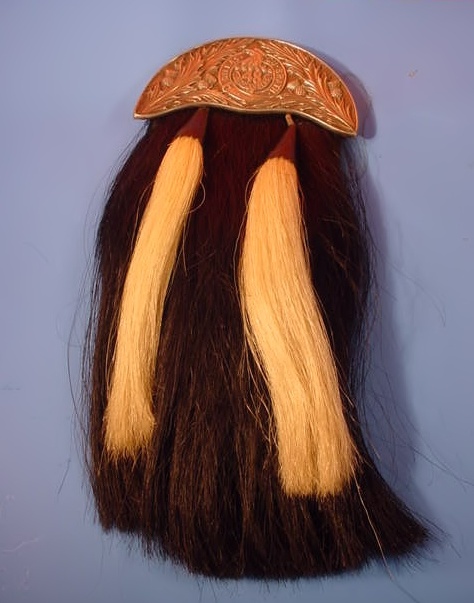 |
48th Highlanders of Canada Sporran, WW II (Item BRITSCOT 4-14) |
DESCRIPTION: The 48th Highlanders, based in Toronto, Canada, was formed in 1881 and had a long-standing tradition of participation in the life of its parent city, Toronto. Members have served in Korea, South Africa, Cambodia, Cypress, Bosnia, and Afghanistan, to name a few. And, of course, they served (unfortunately) in both world wars and participated in Britain’s terrible genocidal war against the Boers in South Africa. The regiment has been aligned with the British Army regiments Seaforth, Gordons, and Camerons. The Sporran is clearly dated 1939 and was used in the fratricidal World War II, when the essentially Scottish regiment went off to battle for the sake of the English. (Don’t get me going on that, it makes the Scottish blood boil within me! I’m related to King Robert the Bruce–the Hammer of the Scots!). How can the people of Bruce willingly go to war against the Germans—who have always been their friends—for the sake of the bloody Brits, who still bask in the memory of Edward Longshanks! It’s an unfortunate fault born of the genetic traits within us Scots to do battle even amongst our own kin, I guess. In any case, the Sporran is a rather nice and authentic piece of Scottish military regalia that is not only neat looking, but historically important and rare. PRICE: $485.00 |
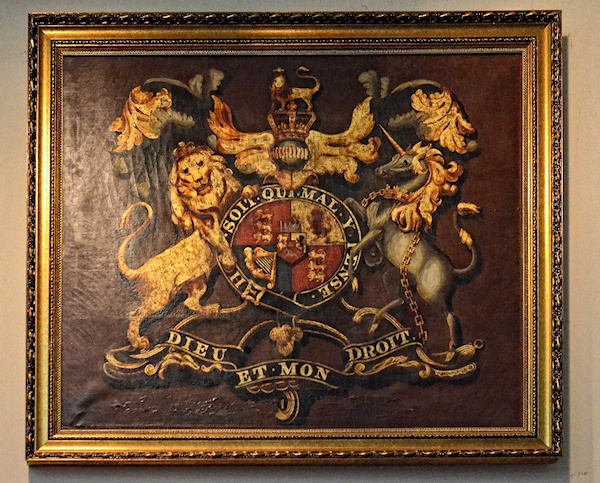 |
British Royal Coat of Arms Hand Painted on Leather (Item BRITSCOT 4-15) |
DESCRIPTION: Here is a spectacular relic of the Victorian era; probably done in the 1850’s period. It’s a depiction of the British royal coat of arms hand painted in rich, vibrant colors. The antique gold was accomplished in those days using actual 24-karat gold mixed with other material. The piece has been framed in an expensive mounting. This item really stands out there and, while looking at it, entranced by its beauty, you just might hear in the distance the strains of “Rule, Britannia!” The crest has the royal cypher of lion and unicorn surmounted with the crown of the empire. In the center is a shield with England-Ireland and Scotland represented. Around the shield is a belt or strap that contains the sovereign’s motto “DIEU ET MON DROIT” (God and my right). Around the shield also is the motto “Honi soit qui mal y pense” (Evil be to him who evil thinks). W. Churchill evidently never read this (*author’s opinion). In any case, this is one imposing depiction and it is surely unique in that it is painted on leather. We have never seen another even in the Royal British Museum or the Victoria and Albert Museum in our many visits there. The frame is about 32 x 22 inches. When a light is centered on it, it stands out magnificently and is almost iridescent. This is a relic of the Great Empire, while it was still an empire. PRICE: $2,500.00 |
|
|
WW-II Vintage RAF Sweetheart Ring (Item BRITSCOT 4-16) |
DESCRIPTION: Here is a petite little ring of the type given by Royal Air Force personnel to their wives or sweethearts as a memento. The piece is in silver with the RAF insignia in its center under the British crown and the wings are stretched around the shank of the ring; all done in enamel. It is marked silver inside. The size is 9 ¾. We are sure it’s of WW II vintage. PRICE: $150.00 |
|
Badge of the 7th Gurka Rifles (India) (Item BRITSCOT 4-17) |
DESCRIPTION: The 7th (Duke of Edinburg’s own) Gurka rifles started as a regiment of the British Indian Army before being transferred to the British Army following India’s independence. Much more about this outfit can be found on Google. The badge is for the dress turban and is finished in a frosted-silver finish. It has the crossed Gurka knives and Nr. 7 as it’s central theme with the British crown at the top. It is a large badge 3 x 4 inches mounted on green-felt cloth. This is a handsome collectable. PRICE: $79.00 |
|
|
|
Dress Dirk of the 71st Highland Light Infantry (Item BRITSCOT 4-17a) |
|
DESCRIPTION: Here is one of the finest military dirks we have ever seen. It is in beautiful (museum-sound) condition throughout and features the cairngorm stone in the pommel, but it is probably more like rock crystal and so are the stones in the wee fork and knife. The seal of the regiment is separately applied to the scabbard throat as all the thistle decorations are featured as well. The deep, rich, gilt patina is remarkably still intact after many years. The blade has the battle honors from Hindoostan in 1803 to Waterloo in 1815; this was the last battle honor, although there are many more to include the Cape of Good Hope in 1806, Corunna in 1809, Vittoria and Nive in 1813, Orthes in 1814, Peninsula 1814, and Waterloo in 1815. The 71st Highland Light Infantry was also known as the 71st Highland Regiment of Foot (Fraser’s Highlanders). In the new-world campaigns, they fought in the French and Indian wars and against Washington in the American Revolutionary War. However, no battle honors are shown for this since the regimental command did not want to honor battle against kith and kin. They have had a long and illustrious career of soldiering in the far-flung regions of the earth, but don’t ask me how I, as a militant Scotsman, feel about Scots serving the Brits! We will not go into that at this time, but you probably catch my meaning, do you not?
The dirk measures about 16 ½ inches long in its scabbard. The blade also has the hunting horn with “71” in its center as emblem of the corps. It also bears the British crown and 13 battle honors, although there certainly were many more. The almost-sacred thistle of Scotia adorns the blade along with a panoply of weapons that are depicted. The grip is fashioned to represent the thistle. This was the style of the Scottish military dirks that evolved after the disaster at Culloden in 1745. The grip of Black wood (sometimes ebony) looks to be carved with interwoven bands of knot work to a style looking much like basket weave with brass studs. On the front of the grip above the guard band in metal is a Napoleonic-era Scots bonnet with crossed claymores behind it, while on the backside of this part is the thistle once again, only this time carved in the wood.
This is a bonnie dirk indeed from an illustrious band of brave ladies. Or is it Ladies from Hell? - - - Scotland the Brave!
PRICE: SOLD |
|
|
|
English (Flintlock) Muff Pistol (Item BRITSCOT 4-18) |
|
DESCRIPTION: Here is a petite flintlock pistol of a type carried by women in the 18th century for protection against ruffians and highwaymen. This type muff or pocket pistol was also carried by gentlemen as well as nasty blackguards for honorable or often nefarious purposes. It was made by the firm of W. Scott in London and this you can see shown on the two sides of the frame. The pistol is all original and in working order as to its component parts: wooden grip, brass barrel. This is a real belly gun of the romantic age; petite but deadly.
PRICE: $850.00 |
|
|
|
|
|
Imperial Russian-Made Badge of the British Most Noble Order of the Garter with Russian Order of Saint Catherine (Item BRITSCOT 4-19; RUSO 5-16) SOLD |
|
DESCRIPTION: Here we present a stunning and prodigiously important piece of royal history in the form of a badge possibly made in Tsarist Russia in the finest workmanship of that time. It was produced by the famed St. Petersburg Keibel-family of jewelers, who were goldsmiths to the Tsars. Gustav Fabergé actually studied under the Keibel’s. The workmanship of this badge reflects all of the skills and remarkable artistic aplomb of that glorious age. The badge depicts the Saint George image that is one of the themes of the British most Noble Order of the Garter, which is the highest order of chivalry that has existed in England and is dedicated to the image of Saint George as England’s patron saint. Membership in the order is limited to the sovereign, the Prince of Wales, and no more than twenty-four members or companions. The order’s emblem, depicted on the insignia, is a garter with the St. George depiction in its center with the motto
“HONI SOIT QUI MAL Y PENSE.”
“Shame on he who thinks evil of it.” There are many legends of how the order came to be, but it is certainly the highest order of knighthood that England would ever bestow. Saint George is the patron saint of soldiers, but also of England. He also was highly revered in Russia in the time of the tsars and again, now, that the horrible communist regime is passé. This piece is said to be bestowed upon a royal lady companion of the order most probably as a state gift from a member of Russian nobility. Was it at some royal event in the Russian motherland or at a state dinner in Great Britain? The badge is quite large measuring 4 ½ inches by 3 inches. It’s constructed in gilt silver with polychrome enamel. The weight is 179.8 grams and measurement is 140mm x 80mm. The Russian Connection On the back of the badge is the depiction of the Russian Order of Saint Catherine beautifully portrayed in rich enamel work seen in a cross of marquisate that appears to look like diamonds, but are not precious stones because both of the official statutes for the two orders forbid it. This award was established by Peter the Great on the occasion of his marriage to Catherine I of Russia and it was the only award bestowed exclusively to the ladies at the order of St. Catherine’s annual function (Compare Garter Service in England) that was held November 24-December 7 on the Georgian calendar. Are you seeing the connection? We may never know exactly who this wonderful badge was given to or what was the occasion or event, where or if it was presented, or even when it was actually made, but the connection between the two empires and the similarity of the orders lead us to the quite obvious theory—or speculation, if you will—that this was a prodigiously important gift meant to be presented to someone of exalted importance. The lady who it was probably meant to be presented to would have to have already been a recipient of the Garter Order. A ‘stranger-lady companion,’ as it was known. (A Lady of the Order). So, here we have the two highest orders of the great empires; one brought down by red revolution, and the other by manipulation of warmongers who were alien to the culture of a once-great nation and now just about a third-world entity. At least for Russia there is a chance under Vladimir Putin to regain the glory and, if not the empire, at least a world leadership position. The medal is marked on the suspension ring with the imperial eagle and the silver mark of “84.” The sheer beauty of it leaves one in awesome recognition of that old saying: A thing of beauty is a joy forever! PRICE: SOLD |
|
|
|
Classic Highland Dirk (Biodag) (Item BRITSCOT 4-20) |
|
DESCRIPTION: Here is the traditional Highland dirk, the classic weapon that is the ceremonial sidearm of the Scottish Highland regiments and also carried as part of Scottish attire among civilians attired in kilt. The traditional Scottish dirk is a development of the second half of the 17th century, when it became a popular item of military equipment In the Jacobite risings. The 78th Frasier Highlanders raised in 1757 wore full Highland dress uniform; their equipment was described by Major James Stewart in 1780 as including a musket and broadsword to which many soldiers added a dirk at their own expense. The modern development of the Scottish dirk into a ceremonial weapon occurred in the 19th century. The shape of the grip developed from the historical more cylindrical form, called a ballock dagger, to a shape intended to represent the thistle of Scotland. The hilts of the newer (1800’s) are carved as this one is from dark-colored wood such as bogwood like this one is. The carved hilts are often lavishly studded with tiny silver studs. When the regiment or the individual was wealthy enough, the fittings would be crafted in silver; this one is with plated brass fittings. It’s probably military and of the soldier’s private purchase as has been noted earlier in this article. I would put the age of this classic weapon at somewhere in the late 19th century. It has the textbook-style small knife and fork set into pockets in the scabbard. It measures a little over 17 inches with scabbard. The blade has the typical zig-zag cutting pattern along the top edge of the blade; this was known as gimping and the effect makes the spine of the blade look like it has dull saw teeth. The blade measures 11 ½ inches long. This is what I would consider the true “biodag” and worthy of a top spot in a collection of Scottish weaponry.
PRICE: SOLD |
|
|
|
Sabretache of the Royal Artillery (Item BRITSCOT 4-21) |
|
DESCRIPTION: The sabretache is one of those strange pieces of military equipment the use or purpose of which often appears incomprehensible to the uninitiated. But, it was an eminently practical—even essential—item in its earliest form having been more of less a plain pouch or haversack worn on the left side by Hungarian horsemen along with their sabres. The German word for pouch is Tasche. Later with the widespread European wars in full flower in the 18th and 19th centuries, the uniform of the Hungarian Hussar became the accepted model upon which most European powers based at least part of their establishment. No self-respecting cavalryman could possibly function as a Hussar if he did not wear a Hungarian motif outfit, and the costume was adopted with variations, of course. Officers of the Light Dragoons had begun to adopt the sabretache in the 1790s and it became a map case and writing base, and in this period it was still utilitarian, but more and more it became merely decorative on the flamboyant uniforms of the time and became very elaborate, laced with monograms and regimental insignia. These decorative dress models were reserved for occasions of Pomp and Circumstance and the rear pocket flaps were seldom and, perhaps never, opened. Many elite British regiments sported these rather gaudy, but beautiful, pieces of military regalia. The earliest of the British regiments to use them were the 26th Light Dragoons officers and the troops who were then mostly in their many empire campaigns. They were the royal artillery and as you can see, a special feature of them is the Royal Arms of England embroidered in genuine gold and silver thread with a metal cannon and inscribed in the bullion thread with the motto Ubique—Quo fas et Gloria Ducunt “Everywhere—Where Right and Glory Lead Us.” This sabretache is in decent shape but shows much use and you can see it shows extensive wear. It was used and it shows! The back pouch is missing, but because these items were decorative only, the men who wore them often removed the pouch as the front piece with the embroidery would fit better against the uniform. More cricket you know! These pieces are very scarce and an item much sought after by collectors.
PRICE: $1,600.00; Reduced to $1,300.00 |
|
|
|
Napoleon’s Nemesis-The Baker Blunderbuss (Item BRITSCOT 4-23, ANTWEP 1-3) |
|
DESCRIPTION: Many gun collectors are familiar with the Baker rifle—Britain’s “Ace in the Hole”—that served the empire well in the Peninsular Campaign and at Waterloo. I am going to call this one “Lord Nelson’s handy-dandy Blunderbuss.” The Baker rifle was a rifled firearm accurate up to 250 yards. It was an improvement on the famed “Brown Bess” and the Bess was the standard military flintlock musket of England for over a hundred years. Gunsmith Ezekiel Baker of 24 White Chapel Road in London patented the Baker rifle. The rifles were equipped with a very distinctive brass patchbox door on the butt and were marked with the word tower and G.R. under a crown (later versions were marked “Enfield”). The brass trigger guard was its most recognizable feature shaped like an elongated ‘S’ enabling a firm grip on the rifle for precise trigger let-off. The stocks were fashioned with a raised cheek piece on the left of the butt, and carried a brass escutcheon at the upper wrist. The weapon is very popular to collectors and they fetch a high premium whenever found. Now! Since we know that these Baker rifles were carried by the Redcoats in the Napoleonic Wars (soldiers of the line) and we know there was also a Baker cavalry carbine, as well, all of them employing these distinctive features, then we would assume that there almost had to be a Baker for naval use! Now for the first time ever we have found the ultra-rare prototype Baker “Blunderbuss.” You will note that stock, lock, butt patchbox, and trigger guard are 100 percent Baker. No other gun has these distinctive features. It just follows that the makers and suppliers in that period would not ignore the needs of Admiral Nelson’s Royal Navy. There are no markings at all on the gun barrel or anywhere else. We earnestly believe we have a unique prototype that may have been made as the prototype, but after Waterloo. The use for it certainly diminished and it evidently was never actually put into production. So, here we have what almost certainly is a unique and prodigiously rare weapon. Baker rifles are some of the most expensive antique firearms ever offered. And of course that would make this twice as rare at least! And at a very reasonable price. Rod Akeroyd in England was recently offering one of the Baker rifles with bayonet for 7,000 pounds sterling.
PRICE: SOLD |
|
|
|
Very Old English Toffee Box (Item BRITSCOT 4-24) |
|
DESCRIPTION: Here is a colorful, little tin box that is from the era of WWI. It definitely shows its age, but still is quite nice as a memento of the “Great War,” that fratricidal war that caused an estimated ten million military deaths and was to be referred to as “The war that would end all wars.” If Churchill, Stalin, and Roosevelt had died at childbirth, maybe there would not ever have been a WWII (author’s personal opinion). The box measures 6 inches across and 4 ¼ inches deep and 4 ½ inches high. There most definitely is a lot of wear and multiple scratches, some of it partially obliterating some of the figures, but as you can see by our pictures most of the beauty and integrity of the whole artistic presentation is there and shines through. On the top we have three of the “war heroes” of fame: Field Marshal Sir J. French, Admiral Sir J. Jellicoe, and Lord Kitchener. On the wide, front panel, it depicts the Battle of Jutland in May 1916. On the back panel, British cavalry charge the German positions. Depicted on one side panel are charging east Indian troopers in the service of the king and on the other, various empire soldiers from four nations who served beside those English chums. Why? In any case, this is a handsome—if a bit tattered—remembrance of “Britain’s Glory.”
PRICE: $175.00 |
|
|
|
Massive “Sinclair” Hilt Sword (Era 1612) (Item BRITSCOT 4-25; ANTWEP 1-6; SCOTWEAPON 1-12) |
|
DESCRIPTION: Here is one of the most homely yet most historically important swords that we have ever obtained. It has the name Sinclair Sword and is named after Colonel George Sinclair who commanded a Scottish mercenary band that tried to fight its way across Norway in 1612, but was routed in the Gudron Valley. Sinclair’s name has ever since been attached to this type of sword hilt. Collectors and weapon experts advance the likely theory that George Sinclair’s mercenaries brought these massive swords to Scotland after cutting a swath of bloody battle across central Europe. These swords were one of the earliest basket-hilt designs and originally were of south-German origin. On average, the blade on one of these massive swords measured from 32 to 38 inches. This one we offer is measured at 33 inches with a thickness of 2 inches wide. “A bonnie blade.” The Sinclair hilt broadsword had great influence on the development of the Scottish basket-hilted Claymore, which was used by Highlanders in the 17th and 18th centuries. After the Jacobean Wars it became for all intents and purposes a symbol of Scotland. The Sinclair sword’s hilt has long recurved quillons with a ring guard or knuckle guard. It has an oversized pommel of the scent-stopper variety. The grip is short with chainmail-type metal wrapping. Sinclair swords all have great broad blades and always are curved with deep fullers as this one has. These swords are very rare and usually seen today for the most part in museums and advanced collections. We have had quite a few Scottish swords, but this one is the earliest one we have ever had. It would be considered in excellent rare condition and “BONNIE WEE WEEAPON” indeed!
PRICE: SOLD |
|
|
|
Wonderful Four-Barreled Flintlock Pistol (Item BRITSCOT 4-26; ANTWEP 1-10) |
|
DESCRIPTION: Here is one of the finest multibarreled firearms we have ever offered or, for that matter, ever seen outside of the greatest weapons displays in the best of museums. This is truly a deadly little charmer. It has everything! Beauty and great functional mechanism. It has all the technical operation that would be expected of a firearm of the modern age yet it obviously is from the mid-18th century. This was the defensive or offensive dream gun because of the time needed to reload a muzzle loaded pistol with single barrel. If you missed or the gun misfired, you undoubtedly would have “bought the farm” so some enterprising gunsmiths sold multibarreled innovations to the landed gentry who could afford them. Flintlocks were designed and produced with two, three, and very rarely with four barrels for multiple shots. These designs were extremely costly to make. This example we offer would have cost a pretty penny in its day. The only one that could have exceeded it in possible effectiveness would have been the famed duck’s foot pistols that have from 4 to 8 barrels and were designed with the idea of a confrontation by one person with a group and all the barrels fired at once. They were popular with bank guards and prison wardens, and sea captains favored them when contemplating possible mutiny. These guns were extremely dangerous because if slightly overloaded with powder they could explode in the hands of the person firing them. They fired with only one flintlock hammer cock igniting all barrels at one time. The example we offer has two flintlock cocks, two triggers, and each barrel fires separately. The bottom barrels are fired with the turn of a lever seen on the side of the lock plate (see our images). The pistol measure nine inches from its butt to the end of the barrels. We can find no company markings, but there is a broad stamping with the number “334” under the grip. This would usually indicate that the weapon would have been issued presumably to a military unit but we thought it to be much too fancy for that. However, some royal factions throughout history and private landed gentry had militias that they funded and directed for personal protection and in the case of their country’s needs these militias would be volunteered to go to battle equipped with some noteworthy and expensive equipment. The gun looks to us to be of British, Irish, or Scottish origin. The latter being a good guess because of the silver tacks embedded in the grip. The side plate has the usual military motif found in pistols of the British Isles and in Irish pieces as well. This is practically always panoply of flags, standards, shield, and weapons. The other floral designs throughout are atypical of the décor-afforded weapons used in Britannia, Scotia, and Erin. The mechanics of the firing action on the gun is nothing short of fabulous and there is even a safety slide devise that locks the hammers tightly when not in use. This was, I am sure, in its day a very expensive piece but, today it is a super bargain.
PRICE: $7,500.00 |
|
|
|
Decorative Powder Horn for Formal Highland Dress (Item BRITSCOT 4-27; SCOTWEAPON 1-13) |
|
DESCRIPTION: Here is a powder horn that would be worn to a pageant or a céilidh by a Scot in Highland formal dress. The clan chieftains in the Victorian age always wore a fancy powder horn accompanied by a beautiful Highland dirk and/or a brace of flint or percussion pistols. This practice of course came down from antiquity and was purely Scottish having no similarity in the cultural traditions of other European nations. In ancient times, the powder horns were functional; not like the item of dress we offer here that does not even have an ingress (opening) to add the powder. Victorian-age horns like this one were purely decorative. Many drawings of early Scot warriors show a couple of pistols tucked into their belt and a powder horn hanging around their neck. But those were the days of Scottish glory when the clans fought against the bloody Brits instead of for them. The Horn The beautiful powder horn that we offer is a prize, really. Literally, many have been exactly that! Often the fanciest ones like this were the first prize in a shooting match, sheepdog contest, or the successful tossing of the mighty caber. This magnificent example is decorated in the finest of Georgian silver trim with two rose-colored Cairngorm stones; one mounted in the side of the horn encased in a silver brooch-looking setting. The other is mounted in the tip that is shaped like the Scottish thistle. This on an actual functional horn would be the end that would pour the powder into the waiting musket. On the other end of the horn on a functioning powder horn would be the cap that would open to receive the powder; however, on this dress accoutrement the cap is stationary and does not open. It is decorated with a large oval crystal jewel that depending on the angle from which it is viewed it can look emerald green or orange opaque. I am particularly impressed with the mid-position hanger loop that holds to the carry chain. It is shaped like an elongated thistle that runs down and clings to the body of the Highland cattle horn. This beauty without (a wee doubt) is indeed a gorgeous Scottish relic of proud old Scotia. PRICE: $1,500.00 |
|
|
|
English “Small Sword” Dated 1712 with Silver Hilt (Item BRITSCOT 4-28; ANTWEP 1-11) |
|
DESCRIPTION: Here is a fine, legitimate 300-year-old “small sword” with an all-silver hilt. We have looked up the English hallmark that looks like a “B” and a large “C” according to a web page by the title “Hallmarks of English and British Silver Maker’s Identification.” This mark is clearly shown as one of the hallmarks of swordsmith Thomas Farren in London 1712. British hallmarks on an item such as this do not lie. This is a 100-percent genuine three-century-old weapon. The Sword This is termed “the small sword” and is considered to be a descendant of the transitional rapier which itself evolved from the original rapier because of the demand for a lighter sword better suited to parrying in the event of duel or self-defense. Colichemarde Blade The shape of this very lethal blade features a wide forte and forte indicates the strong part of the blade; the one third closest to the hilt. The ‘strength’ refers to the control established over the opponent’s weapon. Looking down the length of the blade you will see that it is triangular shaped. This forte then tapers drastically toward the point after the fullers ended but in this example the hexagonal forte extends all the way to the tip. This configuration combines good parrying characteristics. Its lighter weight and superior balance compared to the rapier allowed faster and accurate movement of the blade allowing the wielder to place a more precise thrust on his adversary. The colichemarde first appeared about 1680 and was popular for the next 40 or 50 years at the Royal European courts and it was especially popular with the officers serving in the French and Indian War period, for instance in that particular time the young George Washington possessed one. The sword appeared about the same time as the foil; however, the former was created for practicing fencing at court where the colichemarde was created for dueling. It was perfectly designed for its only purpose and that of course was obviously the art of the ‘kill.’ This particular sword measures 35 inches long including the grip. The blade itself measures 28 ½ inches long. The all-silver grip is silver-wire wrapped and this after 300 years is in remarkably good condition. The “D” guard ends at the pommel with a dragon head. The sword has the typical English loop guard. This refers to the two ringlets that are fashioned to extend from the “D” guard down to the double-clamshell knuckle guard. This is a special feature found only on these particular swords and the sword wielder could put his forefinger through one of these loops thus giving much more of a firm and commanding grip on the sword. Although very pretty, this petite weapon was professionally designed to be the ultimate killing device. To face off with your sword against a man who is an expert swordsman with his colichemarde sword was often tantamount to suicide unless of course you were better yet! PRICE: SOLD |
|
|
|
Fabulous Scottish Military Black Dirk and Plaid Brooch of the “Seaforths” (Item BRITSCOT 4-29) |
|
DESCRIPTION: Here is the best Scots dirk we have ever had the pleasure to offer. It is a weapon as worn by a piper of the famed Seaforth Highlanders (The Ross-shire Buffs, The Duke of Albany’s). This was a historic regiment of the British Army (Why do Scot’s fight for the Brits??). This regiment was associated with large geographical areas of Scotland. The Seaforth Highlanders have varied in size from two battalions during WWI after several mergers. The regiment is now incorporated in the Seaforths, Gordons, and Cameron battalions of the Royal Regiment of Scotland. They fought in many of Britain’s wars, unfortunately.* (*I say that as a Scotsman who remembers the terror that Britain visited upon Scottish folk through the centuries.) The regiment participated in the Battle of the Marne and the Battle of Aisne in 1914, where they suffered heavy casualties, and then the 1st Battalion took part in the Battle of Givenchy, France, after leaving a stint in India in WWII when the 6th Battalion was sent to France as part of the B.E.F. in 1940. The battalion was right in the thick of the “Blitzkrieg” only escaping through Dunkirk thanks to the gracious mercy of the German Führer who never wanted a war with Britain and thus held back the Panzers that could have smashed the Brits right there and then! Nonetheless, the Seaforth lads have been called the “Fightingnest” unit of the armies of Britain. The blade of this dirk testifies to its great involvement in many of the wars and campaigns. All along the blade's length are the ‘battle honors of the Buffs’ including the following: Hindoostan or British India campaign Cape of Good Hope 1806 South Africa 1835 Central India Kabul 1879 Afghanistan 1878-80 Maida 1806 Java 1806 Persia 1857 Locknow 1857 Tel el Kabir 1882 Chitral Expedition 1895 Atbara, Kartoum 1898 Prardeberg South Africa 1899-1902 Marne 1914-1918 Ypres 1915 Loos Somme 1916 Vimy 1917 Cambrai 1917 Hindenburg Line 1918 Palestine 1918 Bagdad 1914-1918 Madagascar 1942 El Alamein 1942 Sicily 1943 Anzio 1944 Middle East 1942 Imphal 1944 Burma 1942-44 Many of these battle honors and military placements are in the blade encased and surrounded by floral and thistle design. The regiment was first formed in 1881 by merging the 72nd (Duke of Albany’s own Highlanders) Regiment of Foot and the 78th Highlands Regiment of Foot 9 (the Ross-shire Buffs) which became the units 1st and 2nd battalions, respectively. It was made the county regiment for seven northern counties including the Orkney Islands. Its motto unfortunately* (*my input) is “Cuidich ‘n Righ” (Help the King) inherited from the 78th Foot. These words are also engraved on the blade below the crown and (“L”) for the Duke of Albany below “Cuidich ‘n Righ” is the Indian elephant in remembrance of the regiment’s long and hard India campaigns. The battle honors are on the opposite side of the blade. The blade is 12 inches long and the entire dirk in its scabbard is 18 inches long. The grip is in what has become known as basket weave with brass studs and the whole grip resembles Scotland’s sacred flower (the thistle.) The end cap or finial is a large, beautiful Cairngorm stone; mine cut and perfect. The little knife and fork traditionally found inserted in the scabbard pockets have singular smaller cairngorms. At the top of the scabbard is a depiction of St. Andrew—Scotland’s Patron Saint—on the cross. At the lower portion of the grip is a depiction of the traditional Scottish feather bonnet as worn by the Highland soldiers in the time of the Napoleonic Wars with Claymore broadswords behind the bonnet. The Plaid Brooch The rest of the elaborate decoration of this magnificent set that will show up in our image gallery with this wonderful dirk is a “plaid brooch” and that is nearly as important as the dirk. It is a large brooch that would be worn at the top portion of a Highland plaid worn over the shoulder of the wearer of a Highland military uniform. It is constructed in heavy silver and bears the same Victorian crown that sits above the letter “L” that lies between the antlers of a Highland stag. All of this is in high relief and separately cast and applied to a wreath covered in laurel leaves and wrapped in ribbons bearing 16 battle honors of the Seaforth Highlanders. This is a super-magnificent jewel in its own right, but being with the dirk it makes for a set that is tremendous in its presentation and it is prodigiously historically important. There are no stamped markings on the brooch except for the letters “E.M.A.” scratched on the back of it. The dirk was made by or marketed by S.J. Pillin, Gerrard St., London West. This magnificent dirk and beautiful plaid brooch are offered at a very reasonable price. PRICE: $11,000.00 |
|
|
|
Gentleman Officer’s What-Not Box of the Royal British Artillery Battery (Item BRITSCOT 4-30; WOODMASTER 1-10) |
|
DESCRIPTION: Here is a fabulous hand-carved wooden box or chest that is decorated on top and all around with elaborately carved oriental dragons and in the center there is a beautiful crest of the Royal Artillery with its crown and cannon. The word under the crown is “UBIQUE,” Latin for “Everywhere,” followed by “QUO FAS ET GLORIA DUCUNT” (Where Right and Glory Lead), which is the motto of the Royal Artillery. It was founded in 1716 and still is active today. It took an active part in the Chinese Boxer Rebellion in 1900 and the Second China War, as well. The chest was either commissioned by an artillery veteran of these conflicts, or presented by a grateful oriental participant who opposed the Boxers and revolutionaries. But, it is obviously made in the Far East. The box is large measuring 12 x 8 inches across the top and 4 inches deep. Inside the lid when opened we can see two more intricately carved dragons that support a circular design. There is a tray divided into four compartments to hide various possessions and when this tray is lifted out there is another compartmentalized section divided in three sections. This chest surely can be called the “Dragon’s depository” as there is no shortage of these beasts so revered by Oriental mythology. What better place to hold the precious memories garnered by a member of this illustrious unit of Britain’s military might that was expended in some of England’s colonial wars that prior to WWI and WWII, perhaps actually should have been fought with numerous exceptions of course.
PRICE: $1,400.00; SPECIAL: reduced to $985.00 |
|
|
|
Uniform Cross Belt Plate of the Royal Highlanders of Canada (Item BRITSCOT 4-31) |
|
DESCRIPTION: Here is a bonnie piece of Scottish military uniform accouterment. It is the brass plate seen on the cross strap on a Scottish theme uniform of one of Canada’s elite Royal Highlanders. This was the 5th Battalion known more commonly as the Black Watch. It was formed in Montreal on January 31, 1862, as the 5th Batt. Volunteer Rifles of Canada. The rise of the American (Yankee) military strength during the Civil War concerned Canada and the government authorized formation of militia regiments. This was one of eight companies formed at that time and the most elite of them all. They later fought in the purely genocidal
Boer War in Africa and every other war since then. ”Why in hell do Scots fight on the side of that nation that should be their ‘mortal enemy’ (bloody Britain)” *(spoken by a nationalistic Scot!). The plate measures 4 x 3 ¼ inches. It is comprised of two separate pieces. The decorative boar’s head, crown, and maple leaf design is all one separately adhered piece attached to the brass plate. The attachments are intact. This is a great decorative and historically important item for any good Scottish collection.
PRICE: $335.00; Reduced - - Special sale – reduced to $200.00 |
|
Magnificent Victorian Sword from the Victoria and Albert Museum in London (Item BRITSCOT 4-32; ANTWEP 2-41) |
DESCRIPTION: Here is a truly handsome old recreation of a medieval knight’s battle sword. This is not a period sword yet it is a legitimate antique being from the reign of Queen Victoria who was England’s queen from 1837 to 1901. Queen Victoria and her husband Prince Albert of Saxe Couburg were both amateur historians. They were appalled that over the centuries before their reign of 63 years many of Britain’s castles and Scotland’s antiquely were stripped of their various regalia such as furniture, paintings, and weaponry. The Victorian Era was a period of industrial, political, scientific, and military change within the United Kingdom, but most of all the great queen’s private interest were all things cultural. She and Albert, with many great artists, sculptors, and metalworkers, set out to reproduce thousands and thousands of lost works of art to be replaced in castles, stately homes, etc., that had been sold or stolen from these important places of the Kingdom’s glory. Some of these replacements were crafted by the direct descendants of the actual original medieval craftsmen that reproduced the initial items of decoration and weaponry including armor and military accoutrements. The old respected firm of Elkington & Co. manufactured many of the silver-plated plaques wine coolers and table settings and is said to have produced some of the recreated weapons and armor. PRICE: $4,500.00 |
|
|
|
Scottish Basket-Hilted Claymore Sword (Claidheamh-mòr: “Great Sword”) (Item BRITSCOT 4-33; SCOTWEAPON 1-14) |
|
DESCRIPTION: This is a nice, solid example of the typical early form of the famed weapon. The blade has light scroll accents that read “For my king and country” indicating it was not only owned by noble families, but was fashioned for military use. It has this moto in both the blood fullers that run most of the length of the blade. The words Scot and bravery are often used in the same sentence, this is no mistake. The Scots at war have a well-earned historical distinction for martial bravery and this is exemplified in the heedless Highland or border Scot charge whereby Clansmen would sweep a foe away in wild hand-to-hand combat and almost always the weapon of choice for the “Geordies” was invariably the great basket-hilted broadsword, one of the most formidable edged weapons inclusive of the swords of the world. The overall construction of this fine example is entirely appropriate for an 18th-century combat weapon. The basket guard is of rugged iron construction with circle- and heart-shaped cutouts on the panels. It has the typical dome pommel (there were several variations noted). It has a wire-wrapped ray-skin grip. It’s in generally good to fine condition. The blade shows a dark patina with scattered pitting, and mild wear is visible overall with the seam on the backside of the grip opening ever so slightly. The fit of the hilt to the blade is solid as a rock and the blade is flexible with fine tone when struck. Note in our images that we have shown a photo of the hornbook on these weapons titled The Scottish Sword: 1600-1945. The author, Harvey J.S. Withers, obviously wanted to show what he considered the classic basket hilt and the most traditional 18th-century example of the claidheamh-mòr. Note that with the exception of the pommel it is virtually identical to the one we offer here. These swords of this circa are getting to be extremely rare and are much sought after—especially in this condition.
PRICE: $7,500.00 |
Page Four |
Please refer to item designator in parentheses in all correspondence.
Please E-mail for any additional information you may need.